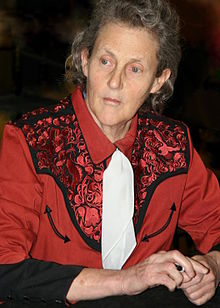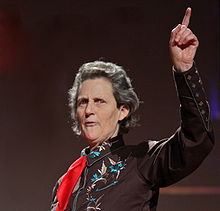From Wikipedia, the free encyclopedia
| Temple B Grandin | |
|---|---|
 |
|
| Born | Mary Temple Grandin[1] August 29, 1947 Boston, Massachusetts, United States |
| Fields | |
| Institutions | Colorado State University |
| Alma mater | |
| Known for |
|
Early life and education
Grandin was born in Boston, Massachusetts, to Eustacia Cutler and Richard Grandin. Although she was diagnosed with autism in 1949 at the age of two, she was labeled with brain damage and placed early in a structured nursery school. When a doctor suggested speech therapy for Grandin, her mother hired a nanny to assist in the child's development. The nanny would spend hours playing turn-taking games with Grandin and her sister.[3]Her speech development delayed, Grandin did not begin talking until the age of four.[4] She considers herself fortunate to have had supportive mentors from elementary school onward. Even so, Grandin states that junior high and high school were the most unpleasant times of her life due to her poor conversational skills. She was the "nerdy kid" whom everyone ridiculed. At times, while she walked down the hallways, her fellow students would taunt her by saying "tape recorder" because of her habit of repetitive speech. Grandin states, "I could laugh about it now, but back then it really hurt."[5]
After she graduated in 1966 from Hampshire Country School, a boarding school for gifted children in Rindge, New Hampshire, Grandin went on to earn her bachelor's degree in psychology from Franklin Pierce College in 1970, a master's degree in animal science from Arizona State University in 1975, and a doctoral degree in animal science from the University of Illinois at Urbana-Champaign in 1989.
Career
Grandin is a prominent and widely cited proponent of the rights of autistic persons and of animal welfare.[6]She has lectured widely about her first-hand experiences of the anxiety of feeling threatened by everything in her surroundings, and of being dismissed and feared, which motivates her work in humane livestock handling processes. She studied the behavior of cattle, how they react to ranchers, movements, objects and light. Grandin then designed adapted curved corrals, intended to reduce stress, panic and injury in animals being led to slaughter.
Her business website promotes improvement of standards in slaughter plants and livestock farms. In 2004 she won a "Proggy" award in the "Visionary" category, from People for the Ethical Treatment of Animals.[7]
One of her notable essays about animal welfare is "Animals Are Not Things",[8] in which she posits that technically, animals are property in our society, but the law ultimately gives them ethical protections or rights. She compares the properties and rights of owning cows, versus owning screwdrivers, enumerating how both may be used to serve human purposes in many ways, but when it comes to inflicting pain, there is a vital distinction between such "properties": legally a person can smash or grind up a screwdriver, but cannot torture an animal legally.
Grandin became well-known after being described by Oliver Sacks in the title narrative of his book An Anthropologist on Mars (1995), for which he won a Polk Award; the title is derived from Grandin's description of how she feels around neurotypical people. She first spoke in public about autism in the mid-1980s, at the request of Ruth C. Sullivan, one of the founders of the Autism Society of America (ASA). Sullivan writes:
I first met Temple in the mid-1980s [at the] annual [ASA] conference. Standing on the periphery of the group was a tall young woman who was obviously interested in the discussions. She seemed shy and pleasant, but mostly she just listened. I learned her name was Temple Grandin. It wasn't until later in the week that I realized she was someone with autism. I approached her and asked if she'd be willing to speak at the next year's [ASA] conference. She agreed. The next year Temple first addressed an [ASA] audience. People were standing at least three deep. The audience couldn't get enough of her. Here, for the first time, was someone who could tell us from her own experience, what it was like to be extremely sound sensitive ("like being tied to the rail and the train's coming"). She was asked many questions: "Why does my son do so much spinning?" "Why does he hold his hands to his ears?" "Why doesn't he look at me?" She spoke from her own experience, and her insight was impressive. There were tears in more than one set of eyes that day. Temple quickly became a much sought-after speaker in the autism community.[9]Based on personal experience, Grandin advocates early intervention to address autism and supportive teachers, who can direct fixations of the child with autism in fruitful directions. She has described her hypersensitivity to noise and other sensory stimuli. She claims she is a primarily visual thinker[10] and has said that words are her second language. Temple attributes her success as a humane livestock facility designer to her ability to recall detail, which is a characteristic of her visual memory. Grandin compares her memory to full-length movies in her head, that may be replayed at will, allowing her to notice small details. She also is able to view her memories using slightly different contexts by changing the positions of the lighting and shadows.
Her insight into the minds of cattle has taught her to value the changes in details to which animals are particularly sensitive and to use her visualization skills to design thoughtful and humane animal-handling equipment. She was named a fellow of the American Society of Agricultural and Biological Engineers in 2009.[11]
As a partial proponent of neurodiversity, Grandin has expressed that she would not support a cure of the entirety of the autism spectrum.[12]
In 2012, when the American beef industry was struggling with public perception of its use and sale of pink slime, Grandin spoke out in support of the food product. She said, “It should be on the market. It should be labeled. We should not be throwing away that much beef."[13]
Personal life
"I think using animals for food is an ethical thing to do, but we've got to do it right. We've got to give those animals a decent life, and we've got to give them a painless death. We owe the animal respect."
—Temple Grandin
Grandin says that "the part of other people that has emotional relationships is not part of me", and she has neither married nor had children. Beyond her work in animal science and welfare and autism rights, her interests include horse riding, science fiction, movies, and biochemistry.
She has noted in her autobiographical works that autism affects every aspect of her life. She has to wear comfortable clothes to counteract her sensory processing disorder and has structured her lifestyle to avoid sensory overload. She regularly takes antidepressants, but no longer uses a squeeze-box (hug machine), a device which she invented at the age of 18 as a form of stress relief therapy,[14] stating in February 2010 that: "It broke two years ago, and I never got around to fixing it. I'm into hugging people now."[15]
Honors
In 2010, Grandin was listed in the Time 100 list of the one hundred most influential people in the world in the "Heroes" category.[2] In 2011, she received a Double Helix Medal.[16] She has received honorary degrees from many universities including Carnegie Mellon University in the United States (2012), McGill University in Canada (1999), and the Swedish University of Agricultural Sciences (2009).[17]In a TED talk given in 2010, Grandin stated, "The world needs all types of minds."[18]
In popular culture
Grandin has been featured on major media programs, such as Lisa Davis's It's Your Health, ABC's Primetime Live, the Today Show, and Larry King Live, the NPR show, Fresh Air with Terry Gross, and she has been written up in Time magazine, People magazine, Discover magazine, Forbes, and The New York Times.[19][20] In 2012, Grandin was interviewed on Thriving Canine Radio to discuss "A Different Perspective on Animal Behavior."She was the subject of the Horizon documentary, “The Woman Who Thinks Like a Cow,” first broadcast by the BBC on June 8, 2006, and Nick News with Linda Ellerbee in the spring of 2006.[21] She also has been a subject in the series First Person by Errol Morris.
Grandin is the focus of a semi-biographical HBO film, entitled Temple Grandin,[22][23] starring Claire Danes as Grandin.[24] The movie was released in 2010, was nominated for 15 Emmys, and received five awards, including Outstanding Made for Television Movie and Best Actress in a Drama.[25] Grandin was on stage as the award was accepted, and she spoke briefly to the audience. Coincidentally, the 2010 Emmy Awards happened on Grandin's birthday. At the 2011 Golden Globes, Claire Danes won a Golden Globe for Best Performance by an Actress in a Mini-Series or Motion Picture Made for Television.
Grandin was featured in Beautiful Minds: A Voyage Into the Brain, a documentary produced in 2006 by colourFIELD tell-a-vision, a German company. She appeared in a 2011 documentary on Sci Channel, "Ingenious Minds".[26] She was named one of 2010's one hundred most influential people in the world by Time magazine.[2]
She also was interviewed by Michael Pollan in his best-selling book, The Omnivore's Dilemma,[27] in which she discussed the livestock industry.
Grandin was also invited to give a lecture at a TEDTalk conference in February 2010. Her lecture discussed the importance of fostering different kinds of minds among young people, particularly focusing on children on the autism spectrum.[28]
Folk-punk band Andrew Jackson Jihad included two songs called "Temple Grandin" and "Temple Grandin Too" on their LP Christmas Island.[29]
Publications
- Emergence: Labeled Autistic (with Margaret Scariano, 1986, updated 1991), ISBN 0-446-67182-7
- The Learning Style of People with Autism: An Autobiography (1995). In Teaching Children with Autism : Strategies to Enhance Communication and Socialization, Kathleen Ann Quill, ISBN 0-8273-6269-2
- Thinking in Pictures: Other Reports from My Life with Autism (1996) ISBN 0-679-77289-8
- Developing Talents: Careers for Individuals with Asperger Syndrome and High-Functioning Autism (2004). ISBN 1-931282-56-0
- Animals in Translation: Using the Mysteries of Autism to Decode Animal Behavior (with Catherine Johnson, 2005), ISBN 0-7432-4769-8
- The Unwritten Rules of Social Relationships: Decoding Social Mysteries Through the Unique Perspectives of Autism (with Sean Barron, 2005), ISBN 1-932565-06-X
- The Way I See It: A Personal Look At Autism And Asperger's (2008), ISBN 9781932565720
- Animals Make Us Human: Creating the Best life for Animals (with Catherine Johnson, 2009), ISBN 978-0-15-101489-7
- The Autistic Brain: Thinking Across the Spectrum (with Richard Panek, 2013), ISBN 978-0-547-63645-0
- Genetics and the Behavior of Domestic Animals, Second Edition (with Mark Deesing, 2013), ISBN 978-0-12-394586-0
- Improving animal welfare: a practical approach (2010). ISBN 978-1-84593-541-2, CABI, UK
- Livestock handling and transport (2007). ISBN 978-1-84593-219-0. CABI, UK.
- Grandin, T. 2013. Making slaughterhouses more humane for cattle, pigs, and sheep. Annual Review of Animal Biosciences. 1:491-512.
- Grandin, T. 2001. Cattle vocalizations are associated with handling and equipment problems at beef slaughter plants. Applied Animal Behaviour Science. Volume 71, 2001, Pg. 191-201.
- Grandin, T. 1996. Factors That Impede Animal Movement at Slaughter Plants. Journal of the American Veterinary Medical Association. 209 No.4:757-759.
- Grandin, T. 1995. Restraint of Livestock. Proceedings: Animal Behaviour Design of Livestock and Poultry Systems International Conference (pages 208-223). Published by: Northeast Regional Agriculture Engineering Service. Cooperative Extension. 152 Riley - Robb Hall, Ithaca, New York, 14853 USA.
- Grandin, T. 1994. Euthanasia and Slaughter of Livestock. Journal of American Veterinary Medical Association. Volume 204:1354-1360.
- Grandin, T. 1989 (Updated 1999). Behavioral Principles of Livestock Handling. Professional Animal Scientist. December 1989 (pages 1–11).

